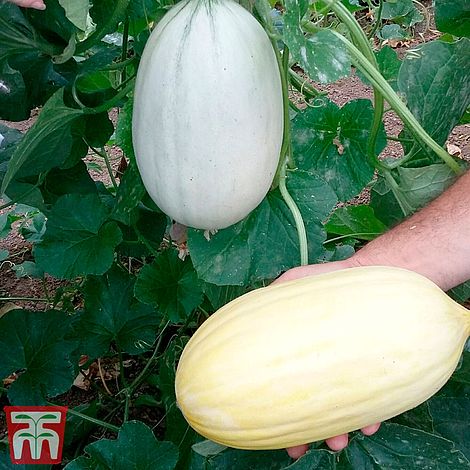




Melon 'Mangomel' F1 Hybrid - SeedsCucumis melo
Half-hardy Annual
A plant that completes its entire life cycle (growth, reproduction, death) in one season.
Can be grown outdoors but requires winter protection from frosts and temperatures below 0C.
£3.49
Mango undertones
Full of flavour
Harvest between July and September
 Height Up to 50cm (20in)
Height Up to 50cm (20in)
Spread Up to 200cm (78in)
 Half-hardy Annual
Half-hardy Annual
 kitchen gardengreenhouse
kitchen gardengreenhouse
 full sun
full sun
You May Also Like
Melon ‘Mangomel’ is a wonderful new kid on the block with mango undertones – amazing! These large, creamy-yellow fruits are full of flavour and so juicy and aromatic. Each plant should produce between 4 and 6 fruits each. For optimum conditions grow in a greenhouse but can also be grown on a sunny patio in the South of the UK or even under a cloche. When the fruit begins to changes from a grey-green tone to its creamy-yellow tones then it is ripe and ready to enjoy. Height: 50cm (20"). Spread: 2m (6', 6").
Melons require high temperatures and humidity. In all but the very warmest areas cultivation is most successful in a greenhouse, or under cover of a cold frame or cloche when growing melons in the UK.
Useful Links:
How to grow fruit from seed
Reasons to buy your seeds from Thompson & Morgan
Show Codes
1 Packet (4 Seeds) (KB9806)
Sow melon seeds from March to mid April for indoor cropping or early April to May for transplanting outdoors later on.
Sow melon seed at a depth of 1cm (½") in trays of free-draining, seed sowing compost. Place in a propagator or seal container inside a plastic bag at a temperature of 20C (68F) until germination which takes 7-10 days. Protect the emerging seedlings from direct sunlight to avoid scorching. Once germinated pot on individual seedlings into 7.5cm (3") pots of compost and grow melon plants on until they large enough to be transplanted into growbags. Maintain a temperature of 20c (68F) and keep the compost barely moist to avoid stem rot.
When melon plants are well grown, transplant 2 plants per growbag or 1m (3') apart under frost free glass, or into frames or cloches outdoors. When growing melons outdoors cover the soil 3-4 weeks before planting with a plastic mulch. Gradually acclimatise them to outdoor conditions over 7-10 days before transplanting into warm, well drained, humus rich soil in full sun, with shelter from winds. Plant in single rows at a distance of 50-90cm (20-36") apart leaving 2m (6') between rows. Pull a little soil around each plant to keep it from touching the plastic mulch. Water well after planting until melons are fully established.
Melon plants can be trained upwards on strings or wires, or allowed to spread flat on the ground. Pinch out the growing point after 5 leaves have formed to encourage lateral shoots to develop. Select 4 vigorous laterals and train these to 6 leaf stage, before pinching out each growing tip. Remove any other laterals. Fruiting sub laterals will then form on each stem.
Water melons regularly, particularly as the flowers develop, and provide a liquid feed every 10-14 days. Shade plants from strong direct sunlight. As the flowers develop, select 4 or 5 female flowers on each plant and hand pollinate them by placing a male flower inside each female bloom. Female melon flowers are identified by a swollen part at the base of the bloom. Once fruit has set remove any further flowers to allow the fruits to develop. Harvest melons when they begin to produce their characteristic sweet smell and the fruits start to crack near to the stem.
Seeds and garden supplies will normally be delivered within the time period stated against each product as detailed above. Plants, bulbs, corms, tubers, shrubs, trees, potatoes, etc. are delivered at the appropriate time for planting or potting on. Delivery times will be stated on the product page above, or in your order acknowledgement page and email.
Orders for packets of seed incur a delivery charge of £2.99.
Orders which include any other products will incur a delivery charge of £6.99.
Where an order includes both packets of seeds and other products, a maximum delivery charge of £7.99 will apply - regardless of the number of items ordered.
Large items may incur a higher delivery charge - this will be displayed in your shopping basket.
Please see our Delivery page for further details, and more information on different charges that may apply to certain destinations.
For more information on how we send your plants please visit our Helpful Guide on plant sizes.
Recently Viewed
Sign Up For Exclusive Special Offers




© 2024 Thompson & Morgan. All rights reserved. A division of Branded Garden Products Limited.





















